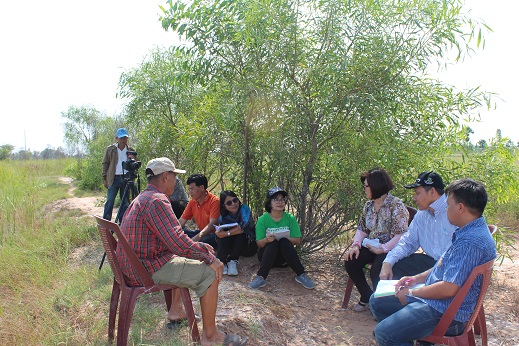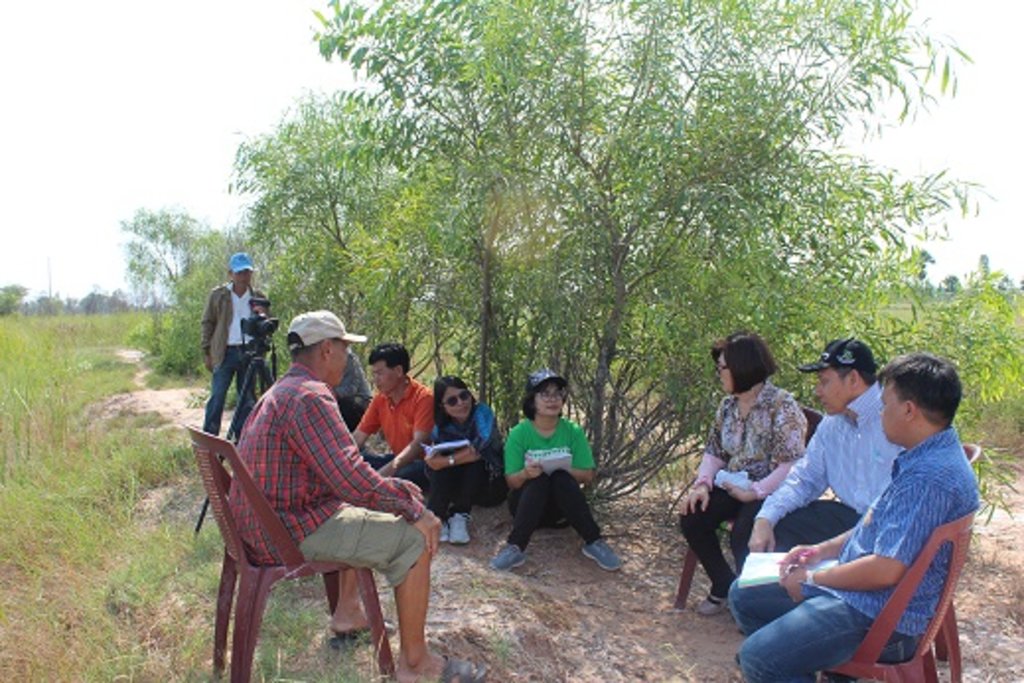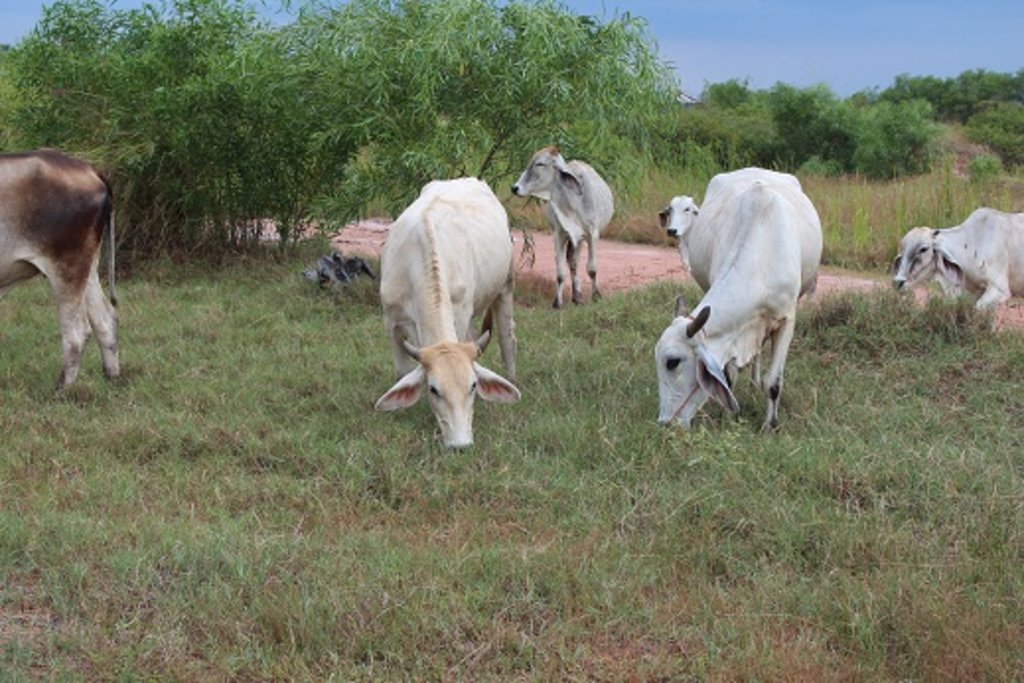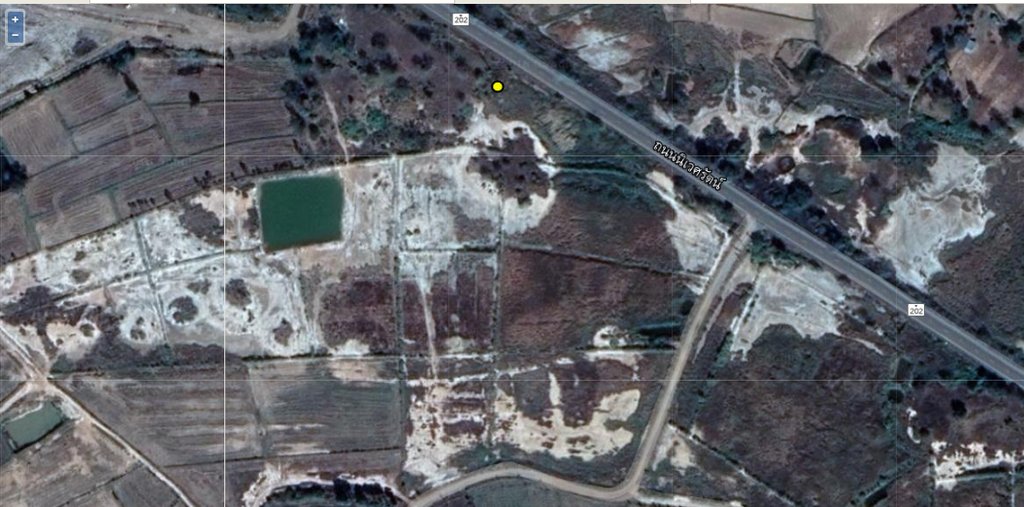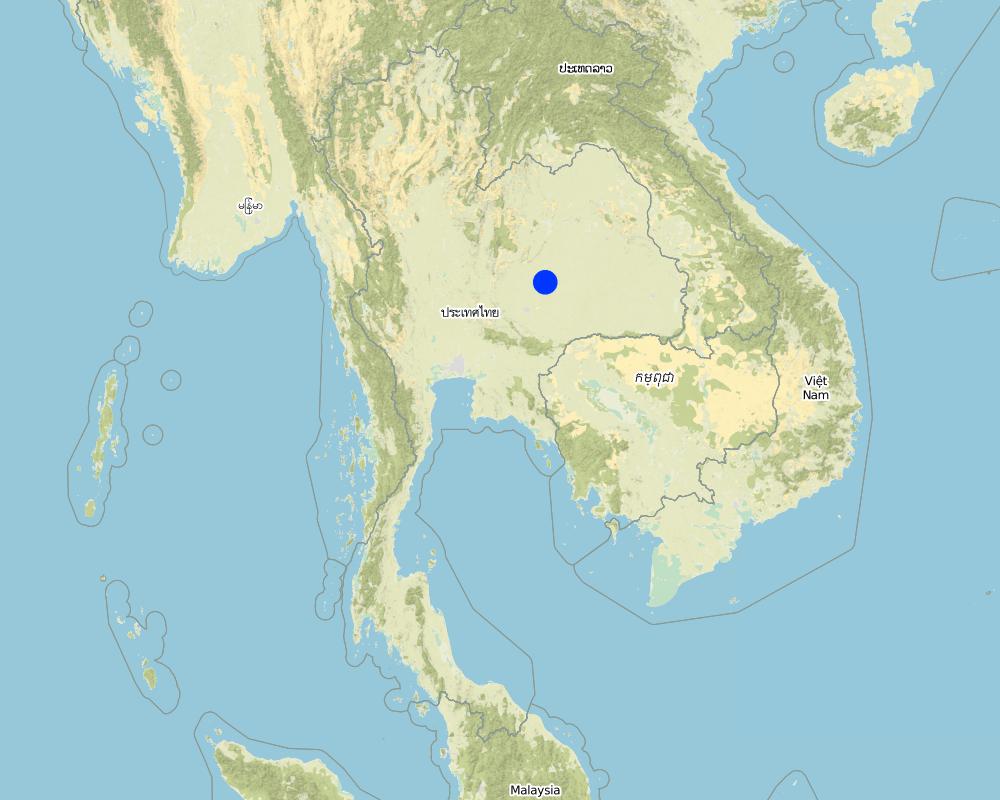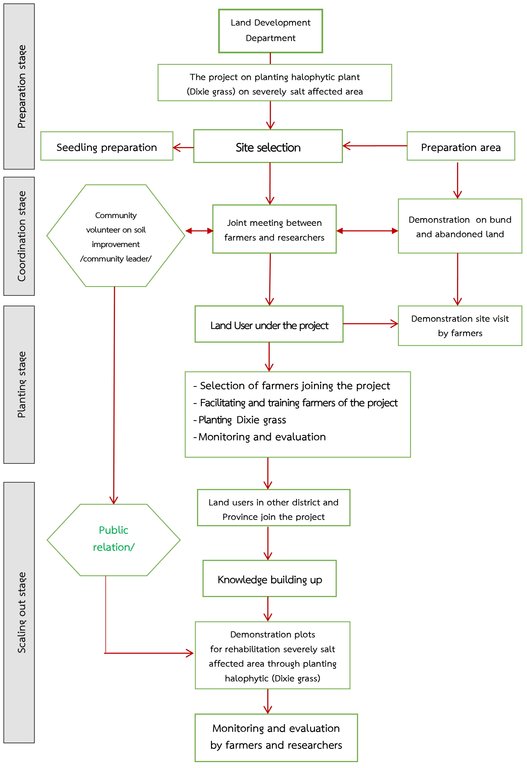Vegetative approach by using halophyte (Dixie grass) to control severely salt-affected land. [Tailandia]
- Creación:
- Actualización:
- Compilador: Kamontip Sasithorn
- Editor: –
- Revisores: Samran Sombatpanit, Rima Mekdaschi Studer, Alexandra Gavilano
approaches_4210 - Tailandia
Visualizar secciones
Expandir todo Colapsar todos1. Información general
1.2 Detalles de contacto de las personas de referencia e instituciones involucradas en la evaluación y la documentación del Enfoque
Persona(s) de referencia clave/s
Usuario de la tierra:
Yooburi Somsak
+66-80-7240599
10 Moo 12, Ban Kut Chok, Kut Chok Sub-district, Buayai District, Nakhon Ratchasima Province 30120
Tailandia
Usuario de la tierra:
Sriwootpong Rungariam
+66-93-4613289
107 Ban Donpae Moo 8, Kut Chok Sub-district, Buayai District, Nakhon Ratchasima Province
Tailandia
Department of Agricultural Extension officer:
Auonpokang Chiwat
+66-85-7783258
Buayai District Agricultural Extension Office
49 Buayai Sub-district, Buayai District, Nakhon Ratchasima Province 30120
Tailandia
Usuario de la tierra:
Kumtisong Noorian
+66-62-1524591
45 Moo 10, Dang-chang Sub-district, Buayai District, Nakhon Ratchasima Province 30120
Tailandia
Especialista MST:
Especialista MST:
Especialista MST:
Especialista MST:
National consultant:
Nombre del proyecto que facilitó la documentación/ evaluación del Enfoque (si fuera relevante)
Book project: where the land is greener - Case Studies and Analysis of Soil and Water Conservation Initiatives Worldwide (where the land is greener)Nombre del proyecto que facilitó la documentación/ evaluación del Enfoque (si fuera relevante)
Book project: where the land is greener - Case Studies and Analysis of Soil and Water Conservation Initiatives Worldwide (where the land is greener)Nombre de la(s) institución(es) que facilitaron la documentación/ evaluación del Enfoque si fuera relevante)
Land Development Department LDD (Land Development Department LDD) - Tailandia1.3 Condiciones referidas al uso de datos documentados mediante WOCAT
¿Cuándo se compilaron los datos (en el campo)?
18/10/2018
El compilador y la/s persona(s) de referencia claves aceptan las condiciones acerca del uso de los datos documentados mediante WOCAT :
Sí
1.4 Referencia/s al/los Cuestionario(s) de Tecnologías MST
2. Descripción del Enfoque MST
2.1 Breve descripción del Enfoque
The government promotes halophytes (Dixie grass) to control severely salt-affected land, rehabilitate the ecosystem and prevent the spread of salt in soil under cooperation of land owners, livestock farmers, local administration, local government agency, Land Development Department researchers and with specialists/ technical advisors in various fields.
2.2 Descripción detallada del Enfoque MST
Descripción detallada del Enfoque MST:
Ministry of Agriculture and Cooperatives by Land Development Department (LDD) had initiated the project on planting salt-tolerant tree and grass on severely salt-affected land in the Northeast of Thailand since 1996. The project had facilitated planting halophyte (Dixie grass) on salt-crusted and barren land since then. The main objectives of approach were to promote the land users to maximize land use for farming, prevent the forming of extensive severely saline soil, to use halophyte (Dixie grass) as cover crop and rehabilitate the ecosystem of severely salt-affected soil. The activities started with public hearing, identifying severely salt-affected areas, set demonstration plot on the farmer’s land as learning center and communication with local administration to call for farmers meeting with detailed work plan and discussion of strengths, weaknesses, opportunities, and threats of planting Dixie grass. The implementing activities consisted of 4 stages; the PREPARATION STAGE was for seedling preparation, site selection of severely salt-affected soil and land preparation, public hearing and establishment of the demonstration plot at Dan Chang Sub-district, Buayai District, Nakhon Ratchasima Province. The COORDINATION STAGE included joint meeting between farmers and researchers, joint monitoring & evaluation and follow up and land users' decision-making. The PLANTING STAGE started from selection of farmers joining the project, facilitating and training farmers, site visit to the demonstration plot, which is the model of planting method established under the project on planting salt-tolerant tree and grass on severely salt-affected land in the Northeast of Thailand. The FINAL ACTIVITY OF SCALING-OUT STAGE: the land users/ farmers favoured this project; after 3 years of planting Dixie grass it was found this barren land became covered by plants and much improved in biodiversity by the evidence of many varieties of wild grasses and flowers, dragonflies, rats and birds. Farmers could now grow rice and they used Dixie grass as feed for livestock. Moreover, and attractively, farmers were able to increase their income. The migration for job to big cities was reduced. The stakeholders were land owners, livestock farmers, local administration, local government agency, researchers and SML specialists from LDD - all worked together with mutual benefit. Although planting halophytes was an improvement method (of vegetative measure) of severely saline soil with low input, the recovery/accomplishment time (in saline soil improvement) could not be as fast as that of the engineering measure with much higher investment.
2.3 Fotos del Enfoque
2.4 Videos del Enfoque
Fecha:
18/10/2018
Lugar:
6 Ban Donpae Moo 8, Kut Chok Sub-district, Buayai District, Nakhon Ratchasima Province
2.5 País/ región/ lugares donde el Enfoque fue aplicado
País:
Tailandia
Región/ Estado/ Provincia:
Nakhon Ratchasima Province
Especifique más el lugar :
6 Ban Donpae Moo 8, Kut Chok Sub-district, Buayai District
Map
×2.6 Fechas de inicio y conclusión del Enfoque
Indique año del inicio:
2015
Año de conclusión (si el Enfoque ya no se aplica):
2016
2.7 Tipo de Enfoque
- proyecto/ basado en un programa
2.8 Propósitos/ objetivos principales del Enfoque
The main objectives of the approach were to promote the land users to maximize land use for farming, to prevent the forming of extensive severely saline soil, to use halophyte (Dixie grass) as cover crop and to rehabilitate the ecosystem of severely salt-affected soil.
2.9 Condiciones que facilitan o impiden la implementación de la/s Tecnología/s aplicadas bajo el Enfoque
normas y valores sociales/ culturales/ religiosos
- facilitan
The land users follow what their neighbours practice.
disponibilidad/ acceso a recursos y servicios financieros
- facilitan
Through the Bank for Agriculture and Agricultural Cooperatives.
entorno institucional
- facilitan
Local administration
colaboración/ coordinación de actores
- facilitan
Coordination of soil doctor volunteers and community leaders in the area.
políticas
- facilitan
The government has the policy to prevent soil degradation.
conocimiento de MST, acceso a apoyo técnico
- facilitan
To provide knowledge to land users in the area.
carga de trabajo, disponibilidad de mano de obra
- facilitan
For land users under the project
- impiden
For land users outside the project
3. Participación y roles de las partes interesadas involucradas
3.1 Partes interesadas involucradas en el Enfoque y sus roles
- usuarios locales de tierras/ comunidades locales
Farmers under the project
Planting halophytes (Sporobolus verginicus - Dixie grass)
- organizaciones comunitarias
Local administration (Sub-district Administration Organization)
Call for meeting
- especialistas MST/consejeros agrícolas
Land Development Department
Site selection
- investigadores
Land Development Department
Provide technical recommendations
- gobierno nacional (planificadores, autoridades)
Land Development Department
Funding, planner, decision-makers
3.2 Involucramiento de los usuarios locales de tierras/ comunidades locales en las distintas fases del Enfoque
| Involucramiento de los usuarios locales de tierras/ comunidades locales | Especifique quién se involucró y describa las actividades | |
|---|---|---|
| iniciación/ motivación | interactivo | Land users in the project based |
| planificación | pasivo | Discussion with land users on work plan before starting the activity. |
| implementación | apoyo externo | Land users/farmers in the project |
| monitoreo y evaluación | apoyo externo | Land users in the project |
3.3 Flujograma (si estuviera disponible)
Descripción:
Four stages of participating process of technology development among organizations, community volunteers on soil improvement, farmers, SML specialists and researchers.
Autor:
Kamontip Sasithorn
3.4 La toma de decisiones en la selección de Tecnología(s) MST
Especifique quién decidió la selección de las Tecnología/ Tecnologías a implementarse:
- principalmente por especialistas MST en consulta con usuarios de tierras
Especifique las bases que sustentaron la toma de decisiones:
- la evaluación de conocimiento MST bien documentado (la toma de decisiones se basa en evidencia)
4. Apoyo técnico, fortalecimiento institucional y gestión del conocimiento
4.1 Construcción de capacidades / capacitación
¿Se proporcionó la capacitación a usuarios de tierras/ otras partes interesadas?
Sí
Especifique quién fue capacitado:
- usuarios de tierras
Forma de capacitación:
- áreas de demostración
- reuniones públicas
Temas avanzados:
Prevention and rehabilitation of salt-affected land with available technology and increased income for farmers.
4.2 Servicio de asesoría
¿Los usuarios de tierras tienen acceso a un servicio de asesoría?
Sí
Especifique si servicio proporcionado se realizó:
- en los campos de los usuarios de tierras
Describa/ comentarios:
1. Soil doctor volunteers represent the Land Development Department with duty in providing knowledge to farmers in the area.
2. SLM specialists from Land Development Department visited and advised farmers in the area.
4.3 Fortalecimiento institucional (desarrollo institucional)
¿Se establecieron o fortalecieron instituciones mediante el Enfoque?
- no
4.4 Monitoreo y evaluación
¿El monitoreo y la evaluación forman parte del Enfoque?
Sí
Comentarios:
SLM specialists from Land Development Department collaborated with LDD soil doctor volunteers in surveying the survival rate and following up the growth of plants in the area.
Si respondió que sí, ¿la documentación se utilizará para monitoreo y evaluación?
Sí
4.5 Investigación
¿La investigación formó parte del Enfoque?
Sí
Especifique los temas:
- tecnología
Proporcione detalles adicionales e indique quién hizo la investigación:
The Soil Salinity Research Group, LDD, conducted research on "halophytes plantation and the flow path along the landscape in Northeast Thailand" with Dr. J.L. Gallagher from Delaware Biotechnology Institute, University of Delaware.
5. Financiamiento y apoyo material externo
5.1 Presupuesto anual para el componente MST del Enfoque
Si no se conoce el presupuesto anual preciso, indique el rango:
- < 2,000
Comentarios (ej. fuentes principales de financiamiento/ donantes principales):
Land Development Department
5.2 Apoyo financiero/material proporcionado a los usuarios de tierras
¿Los usuarios de tierras recibieron financiamiento/ apoyo material para implementar la Tecnología/ Tecnologías? :
Sí
Si respondió sí, especifique el tipo o los tipos de apoyo, condiciones y proveedor(es) :
Dixie grass seedlings and land preparation cost
5.3 Subsidios para insumos específicos (incluyendo mano de obra)
- mano de obra
| En qué grado | Especifique los subsidios |
|---|---|
| totalmente financiado | Planting |
- otro
| Otro (especifique) | En qué grado | Especifique los subsidios |
|---|---|---|
| seeding | totalmente financiado | free seedings |
Si la mano de obra de usuarios de tierras fue un insumo sustancial, ¿fue:
- pagado en efectivo?
Comentarios:
Labour by land users and employees; due to the landowner has insufficient labor for grass planting. Therefore, need to hire workers to grow by paying wages a day 175 THB/person (the minimum rate)
5.4 Crédito
¿Se proporcionó crédito bajo el Enfoque para actividades MST?
No
5.5 Otros incentivos o instrumentos
¿Se usaron otros incentivos o instrumentos para promover la implementación de Tecnologías MST?
No
6. Análisis de impacto y comentarios de conclusión
6.1 Impactos del Enfoque
¿El Enfoque empoderó a los usuarios locales de tierras, mejoró el involucramiento de las partes interesadas?
- No
- Sí, un poco
- Sí, moderadamente
- Sí, mucho
Generate food security and family income.
¿El Enfoque facilitó la toma de decisiones basada en evidencia?
- No
- Sí, un poco
- Sí, moderadamente
- Sí, mucho
Establish learning center for farmers as an information for technology adoption.
¿El Enfoque ayudó a los usuarios de tierras a implementar y mantener Tecnologías MST?
- No
- Sí, un poco
- Sí, moderadamente
- Sí, mucho
Farmers well adopted the technology, resulting in the expansion of such Approach to a wider area.
¿El Enfoque mejoró el conocimiento y capacidades de los usuarios para implementar MST?
- No
- Sí, un poco
- Sí, moderadamente
- Sí, mucho
Farmers have adapted and changed SLM model to suit their own preference.
¿El Enfoque resultó en mejor seguridad alimentaria/ mejoró la nutrición?
- No
- Sí, un poco
- Sí, moderadamente
- Sí, mucho
Farmers can grow rice and they use Dixie grass as feed for livestock.
¿El Enfoque llevó a oportunidades de empleo, ingresos?
- No
- Sí, un poco
- Sí, moderadamente
- Sí, mucho
The migration for job to big cities has reduced.
6.2 Motivación principal del usuario de la tierra para implementar MST
- producción incrementada
From the interview, farmers were satisfied with this technology of Sporobolus virginicus planting to rehabilitate severely saline soil. Besides being lower in salination farmers got more rice yields and better environment and livelihoods.
- reducción de la degradación de la tierra
After 3 years of planting Dixie grass, it was found that the formerly barren land became covered by plants and much improved in biodiversity by the evidence of many varieties of wild grass, dragonflies, rats and birds.
6.3 Sostenibilidad de las actividades del Enfoque
¿Pueden los usuarios de tierras sostener lo que se implementó mediante el Enfoque (sin apoyo externo)?
- sí
Si respondió que sí, describa cómo:
Farmers have better understanding and positive attitude of planting halophytes (Dixie grass). Moreover, they have more income generated from rice yield and livestocks, as farmers could now grow rice and used Dixie grass to raise livestock.
6.4 Fortalezas/ ventajas del Enfoque
| Fuerzas/ ventajas/ oportunidades desde la perspectiva del usuario de la tierra |
|---|
| Soil doctor volunteer, local government agency and community leader were the coordinators in the area. |
| Farmers had easy access to markets and sources of Dixie grass seedlings. |
| Distribution of Dixie grass seedling was done at no cost. |
| Fuerzas/ ventajas/ oportunidades desde la perspectiva del compilador o de otra persona de referencia clave |
|---|
| A supported technique created to make better environment on severely saline soil in the Northeast of Thailand. |
| Technique in planting Dixie grass was provided continually by Land Development Department and community volunteers on soil improvement. |
| A demonstrated plot was established in the area. |
6.5 Debilidades/ desventajas del Enfoque y formas de sobreponerse a ellos
| Debilidades/ desventajas/ riesgos desde la perspectiva del usuario de la tierra | ¿Cómo sobreponerse a ellas? |
|---|---|
| Advertising of project was not extensive enough, particularly to the area of severely saline soil. | It is necessary for the Land Development Department to cooperate more closely with local administration to promote the project. |
| Debilidades/ desventajas/ riesgos desde la perspectiva del compilador o de otra persona de referencia clave | ¿Cómo sobreponerse a ellas? |
|---|---|
| Some farmers did not believe that Dixie grass was very salt tolerant and will make the salinity of the soil decrease after planting it. | The officers should build up knowledge from successful farmers by frequently visiting farmers in the area under the project "rehabilitation of severely salt-affected soil by planting Dixie grass". |
7. Referencias y vínculos
7.1 Métodos/ fuentes de información
- entrevistas con usuarios de tierras
- entrevistas con especialistas/ expertos en MST
7.2 Referencias a publicaciones disponibles
Título, autor, año, ISBN:
Land Development Department
¿Dónde se halla disponible? ¿Costo?
http://www.ldd.go.th/
7.3 Vínculos a la información relevante disponible en línea
Título/ descripción:
where the land is greener - Case Studies and Analysis of Soil and Water Conservation Initiatives Worldwide
URL:
https://www.wocat.net/library/media/27/
Título/ descripción:
where people and their land are safer - A Compendium of Good Practices in Disaster Risk Reduction (DRR) (where people and their land are safer) URL:
URL:
https://www.wocat.net/en/projects-and-countries/projects/drr
Vínculos y módulos
Expandir todo Colapsar todosVínculos
No hay vínculos
Módulos
No se hallaron módulos


